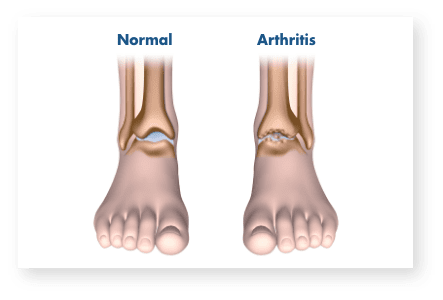IMPORTANT INFORMATION ABOUT ANKLE REPLACEMENT
Contra-Indications: Active or prior deep infection in the ankle joint or adjacent bones, Skeletal immaturity, Bone stock inadequate to support the device including: Severe osteoporotic or osteopenia condition or other conditions resulting in poor bone quality , Avascular necrosis of the talus, Prior surgery and / or injury that has adversely affected ankle bone quality, Malalignment or severe deformity of involved or adjacent anatomic structures including: Hindfoot or forefoot malalignment precluding plantigrade foot, Significant malalignment of the knee joint. Insufficient ligament support that cannot be repaired with soft tissue stabilization, Neuromuscular disease resulting in lack of normal muscle function about the affected ankle, Lower extremity vascular insufficiency demonstrated by Doppler arterial pressure, Charcot joint or peripheral neuropathy that may lead to Charcot joint of the affected ankle, Prior arthrodesis at the ankle joint , Poor skin and soft tissue quality about the surgical site.
Common Side Effects from Total Ankle Replacement Surgery: For the first two weeks after surgery it is normal to have a moderate amount of pain. You may need to use pain medicine(s). This pain may slowly decrease over time, but it is not unusual to experience some discomfort for up to three months and swelling may continue for up to a year after surgery. Contact your surgeon right away if at any time you notice: Fluid leaking from your wound, Redness around your wound, Pain or swelling that starts suddenly (especially after an ankle twist or fall) or Severe pain after the initial two weeks following your surgery.
The T2 Ankle Arthrodesis Nail is intended for tibiotalocalcaneal arthrodesis (fusion) and to provide stabilization of the hindfoot and ankle including the transverse tarsal joints coupling the mid-foot to the hindfoot. Examples of specific indications include: Post-traumatic or primary arthrosis, previously infected arthrosis (second degree), revision of Failed Ankle arthrodesis, failed Total Ankle Replacement, avascular Necrosis of the Talus (requiring tibiocalcaneal arthrodesis), Neuroarthropathy or Neuromuscular Deformity or other neuromuscular disease with severe deformity or instability of the ankle, rheumatoid arthritis with severe deformity such as rheumatoid hindfoot, osteoarthritis, nonunions or pseudarthrosis of hindfoot and distal tibia, malunited tibial pilon fracture, charcot foot, severe endstage degenerative arthritis, severe defects after tumor resection pantalar arthrodesis.
Contraindications: The physician’s education, training and professional judgement must be relied upon to choose the most appropriate device and treatment. Conditions presenting an increased risk of failure include: any active or suspected latent infection or marked local inflammation in or about the affected area. Compromised vascularity that would inhibit adequate blood supply to the fracture or the operative site. Bone stock compromised by disease, infection or prior implantation that can not provide adequate support and/or fixation of the devices. Material sensitivity, documented or suspected. Obesity. An overweight or obese patient can produce loads on the implant that can lead to failure of the fixation of the device or to failure of the device itself. Patients having inadequate tissue coverage over the operative site. Implant utilization that would interfere with anatomical structures or physiological performance. Any mental or neuromuscular disorder which would create an unacceptable risk of fixation failure or complications in postoperative care. Other medical or surgical conditions which would preclude the potential benefit of surgery. The T2 Ankle Arthrodesis Nail should NOT be used if following conditions are present: tibial malalignment of > 10˚ in any plane, severe vascular deficiency, osteomyelitis or soft tissue infection.
The information presented is for educational purposes only. Stryker is not dispensing medical advice. Please speak to your doctor to decide if joint replacement surgery is right for you. Only your doctor can make the medical judgment which products and treatments are right for your own individual condition. As with any surgery, joint replacement carries certain risks. Your surgeon will explain all the possible complications of the surgery, as well as side effects. Additionally, the lifetime of a joint replacement is not infinite and varies with each individual. Also, each patient will experience a different postoperative activity level, depending on their own individual clinical factors. Your doctor will help counsel you about how to best maintain your activities in order to potentially prolong the lifetime of the device. Such strategies include not engaging in high-impact activities, such as running, as well as maintaining a healthy weight.
CP-AWI-1, 12-2015
Please upgrade your internet browser.
Our website was designed for a range of browsers. However, if you would like to use many of our latest and greatest features, please upgrade to a modern, fully supported browser.
Find the latest versions of modern supported browsers »Note: If you are browsing in Internet Explorer 9 or later, and you are still seeing this message, you may be in Compatability Mode. Look for the Compability View icon in your Address bar, or the Compatability View and Compatability View settings from the Tools Menu in your Internet Explorer toolbar (hit the ALT key if your menu bar is hidden). If you are on an Intranet, you may need to contact your IT Support about Compatability View settings and whitelists.
